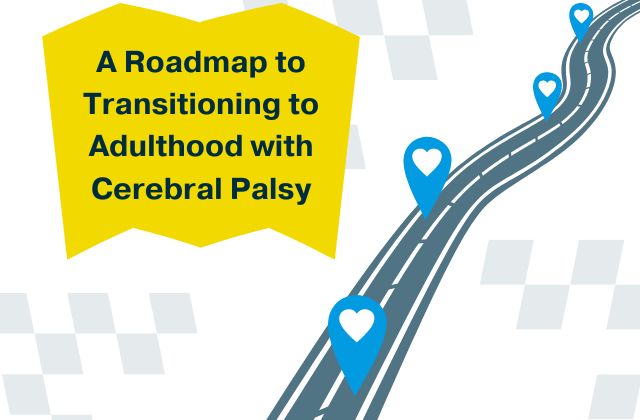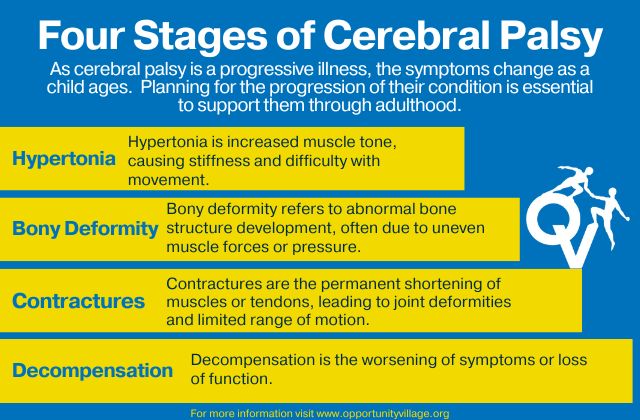
Cerebral palsy is a lifelong condition. So, for children with cerebral palsy, adulthood will present unique challenges but also new opportunities to live independently and thrive. With the support of their parents or guardians and community, the transition into adulthood can be smooth and joyful.
Here is how to provide the support your child needs as they move into the next stage of life with cerebral palsy.
What Types Of Support Do Adults With Cerebral Palsy Need?
Parents looking to address the support needs of their children with cerebral palsy into adulthood need to first understand how the disease progresses with age. Here are four common questions answered about the health needs of adults with cerebral palsy:
1. What Are The Four Stages Of Cerebral Palsy?
As cerebral palsy is a progressive illness, the symptoms change as your child ages. Here are the four stages of cerebral palsy:
- Hypertonia: Hypertonia is increased muscle tone, causing stiffness and difficulty with movement.
- Contractures: Contractures are the permanent shortening of muscles or tendons, leading to joint deformities and limited range of motion.
- Bone Deformity: Bone deformity refers to abnormal bone structure development, often due to uneven muscle forces or pressure.
- Decompensation: Decompensation is the worsening of symptoms or loss of function.
Planning for the progression of their condition is essential to support them through adulthood.

2. What Happens To People With Cerebral Palsy When They Get Older?
For people with cerebral palsy, adulthood comes with numerous challenges. As they get older, they may experience increased fatigue and a decline in mobility due to the strain of managing their condition over time. Musculoskeletal issues can also become more pronounced. Further, they may struggle with mental health challenges, including depression and anxiety. However, with the right medical, therapeutic, and social support systems, they can live a full and happy life.
3. What Health Issues Do Adults With Cerebral Palsy Face?
As adults with cerebral palsy age, they can experience increasing health issues, including:
- Musculoskeletal Problems: Joint pain, arthritis, and muscle contractures are common.
- Neurological Issues: Seizures, which may have been present in childhood, can persist or develop in adulthood.
- Digestive Problems: Difficulty swallowing (dysphagia) and gastroesophageal reflux disease (GERD) are frequent concerns.
- Respiratory Issues: Increased risk of respiratory infections and complications due to reduced mobility and aspiration risks.
- Mental Health: Higher prevalence of depression and anxiety due to chronic pain, social isolation, and other factors.
To support the evolving health needs of adults with cerebral palsy, you will need to make the proper accommodations.
4. What Accommodations Do Adults With Cerebral Palsy Typically Need?
Adults with cerebral palsy may require various accommodations to help them live more independently and comfortably:
- Mobility Aids like wheelchairs, walkers, and scooters to assist with movement.
- Home modifications like ramps, widened doorways, and accessible bathrooms to improve home accessibility.
- Assistive tools such as communication devices, adaptive utensils, and computer accessibility software.
- Modified workspaces, flexible work hours, and remote work options to accommodate physical limitations.
- Accessible transportation options, such as paratransit services, to facilitate mobility and independence.
Making these accommodations can help support their physical, mental, and lifestyle needs.
How To Plan Your Child’s Transition To Adulthood – The Paperwork
To start your child’s transition into adulthood, you will need to establish an Individualized Education Program (IEP) with the state of Nevada.
In Nevada, IEPs typically begin at age 14 but can be established younger. An IEP is a customized plan to help children with cerebral palsy transition into adulthood and support the development of independent living skills.
Once the IEP is established, you can then start working on the legal documents for government and financial support programs. These will help you ensure your child has the financial means to live comfortably and get the right care.
Here are some of the things you will need to do:
- File A Guardianship Petition: If the child with CP is unable to make decisions independently, parents may need to file for legal guardianship.
- Consider Private Insurance: Some plans allow children with disabilities to remain on their parent’s insurance beyond the typical age limit. Check with your provider to see what coverage you can offer.
- Apply For Medicaid: Medicaid provides health coverage for individuals with disabilities, even if they have private insurance.
- Apply For Medicare: If your child qualifies for Social Security Disability Insurance (SSDI), they could also become eligible for Medicare after a waiting period.
- Apply For Supplemental Security Income (SSI): SSI offers monetary support to disabled individuals with restricted income and resources.
- Apply For SSDI Application: If the child has worked and paid into Social Security, or if a parent is retired, disabled, or deceased, the child might be eligible for SSDI benefits.
- Establish Special Needs Trusts: Establish a special needs trust to ensure the child can receive inheritance or other funds without being disqualified from government benefits.
- Consider An Achieving a Better Life Experience (ABLE) Account: ABLE accounts allow for tax-advantaged savings for disability-related expenses without affecting eligibility for SSI and Medicaid.
- Draft A Will: Designate a guardian for the child and specify how assets should be managed and distributed.
- Create A Living Will: Create a living will to outline medical treatment preferences in case the child is unable to communicate their wishes.
- Establish A Power of Attorney: Designate a durable proxy to make medical decisions for the child if they become unable to do so.
- Look Into Housing Options: Research housing options like supported living arrangements, group homes, or independent living with assistance.
With robust financial and legal planning, you can protect your child’s rights, safety, and comfort for their entire lives.
Post-Secondary Educational Options For Adults With Cerebral Palsy
Once your child leaves high school, they can enter the workforce or pursue secondary education options, including:
- University or community college with disability support services
- Trade schools, vocational training, and apprenticeship programs
- Adult education centers
- Certification programs
- Adaptive skill training workshops
Your child’s educational pathway depends on their career goals and accommodation needs.
Employment Opportunities And Resources For Adults With Cerebral Palsy
If your child is ready to enter the workforce, there are also a number of opportunities for employment to consider, including:
- Supported employment programs
- Sheltered workshops
- Part-time, flexible, and remote positions
- Government employment initiatives
- Inclusive businesses and organizations
There are many options available for adults with cerebral palsy to pursue their careers.
For your child with cerebral palsy, adulthood can seem daunting. However, with the right preparation, you can set your child up for a long, happy life. At Opportunity Village, we offer support to help people transition to adulthood.
Check out our Job Discovery Program for high school students with disabilities. Our job discovery program provides vocational training and personalized support to help them develop the skills needed for successful careers.
You can also join us for workshops and get resources to help support you and your loved one along the way.







